Conflict Resolution Program for Workplace Relationships
VerifiedAdded on 2022/08/26
|7
|1052
|22
Report
AI Summary
This report outlines a Relationship Improvement Program designed to address and resolve workplace conflicts, specifically focusing on cultural and racial discrimination. The program targets conflicts between team leaders/management and employees, particularly concerning issues like hair texture and skin color-based discrimination against African American female workers. The program's design incorporates a five-system method, including awareness, self-preparation, conflict reduction, negotiation, and agreement phases. The expected outcome is to establish cultural competence among participants, improve leadership effectiveness, and foster collaboration to handle cultural discrimination issues appropriately. The report also includes references to relevant academic sources supporting the program's framework and objectives.
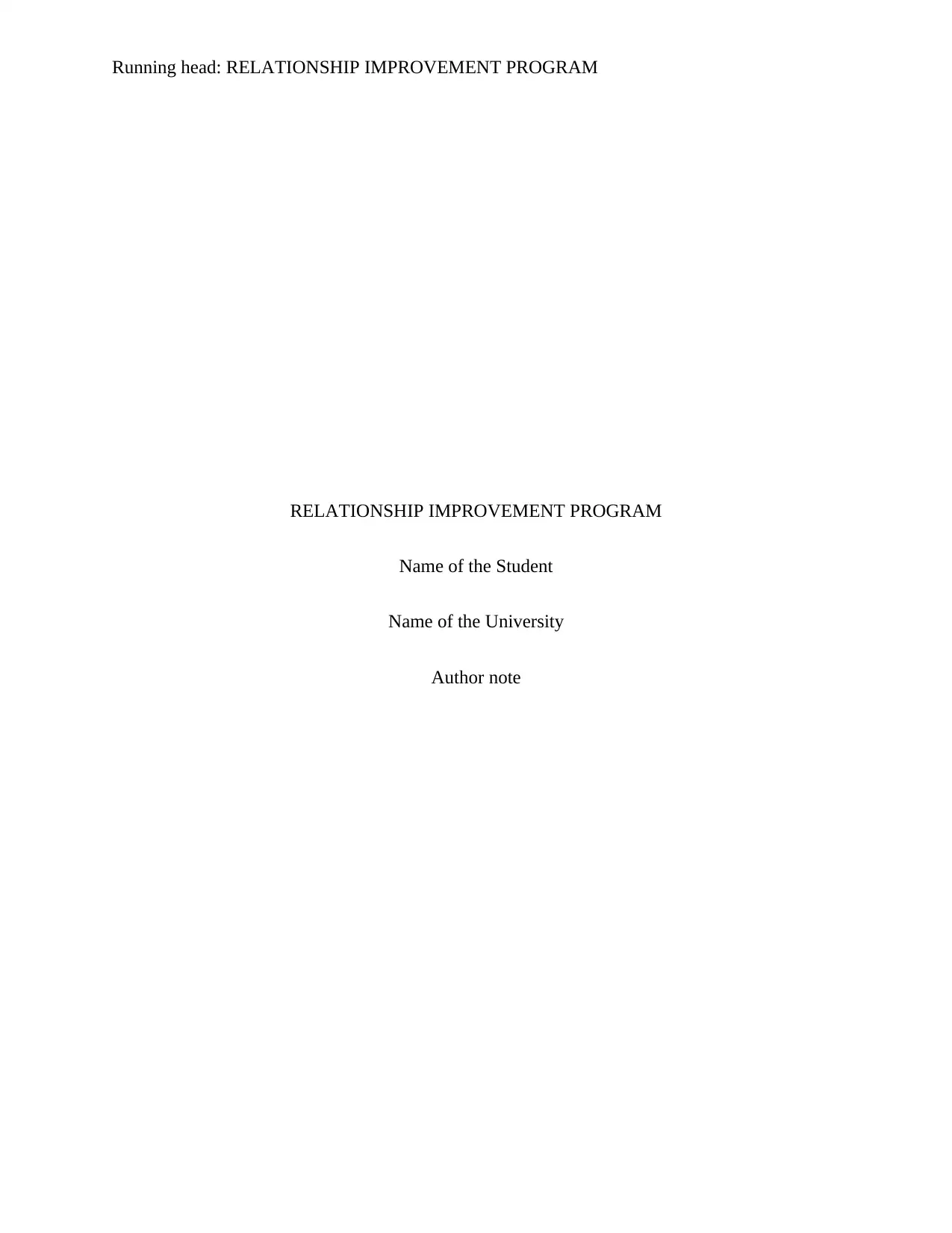
Running head: RELATIONSHIP IMPROVEMENT PROGRAM
RELATIONSHIP IMPROVEMENT PROGRAM
Name of the Student
Name of the University
Author note
RELATIONSHIP IMPROVEMENT PROGRAM
Name of the Student
Name of the University
Author note
Paraphrase This Document
Need a fresh take? Get an instant paraphrase of this document with our AI Paraphraser
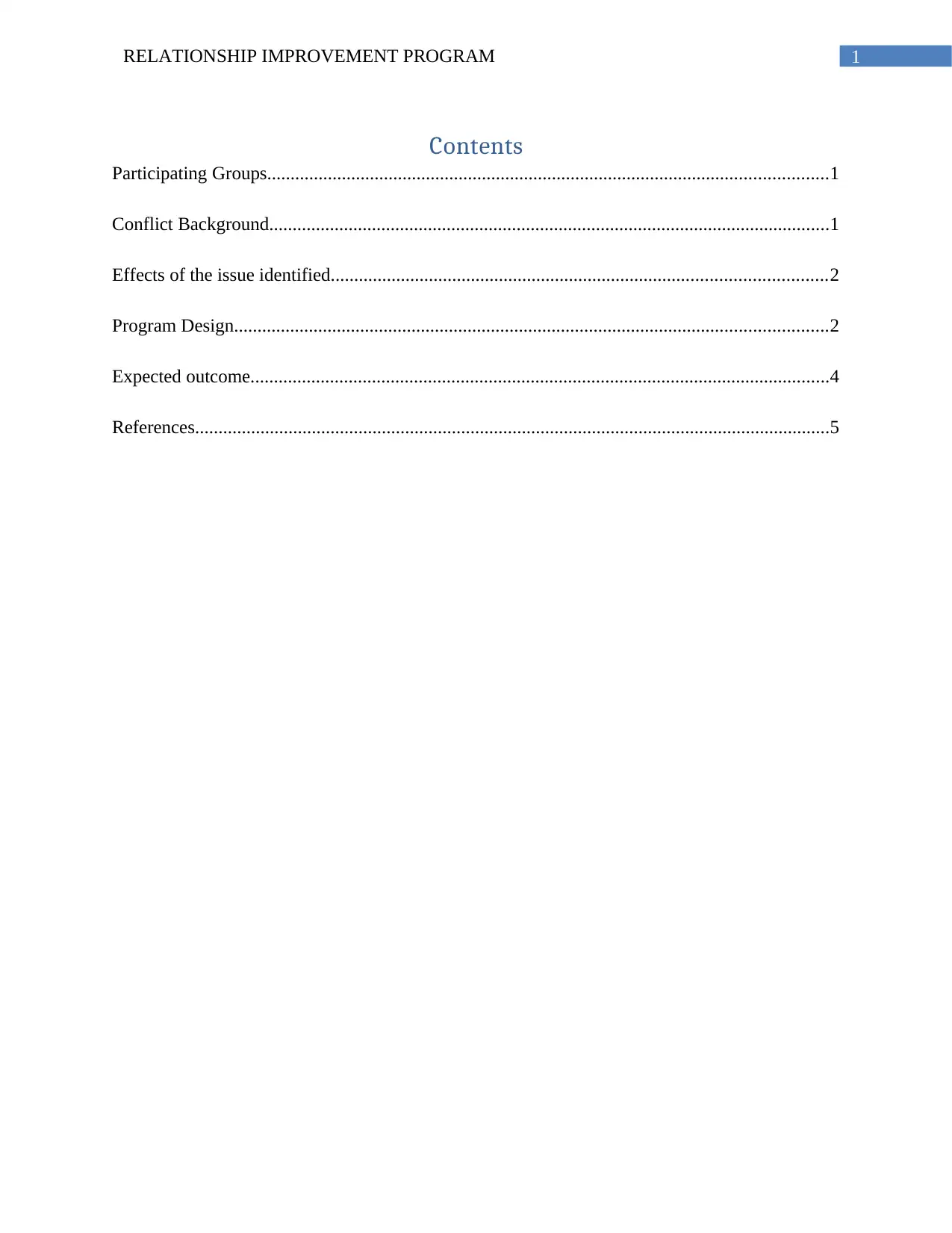
1RELATIONSHIP IMPROVEMENT PROGRAM
Contents
Participating Groups........................................................................................................................1
Conflict Background........................................................................................................................1
Effects of the issue identified..........................................................................................................2
Program Design...............................................................................................................................2
Expected outcome............................................................................................................................4
References........................................................................................................................................5
Contents
Participating Groups........................................................................................................................1
Conflict Background........................................................................................................................1
Effects of the issue identified..........................................................................................................2
Program Design...............................................................................................................................2
Expected outcome............................................................................................................................4
References........................................................................................................................................5
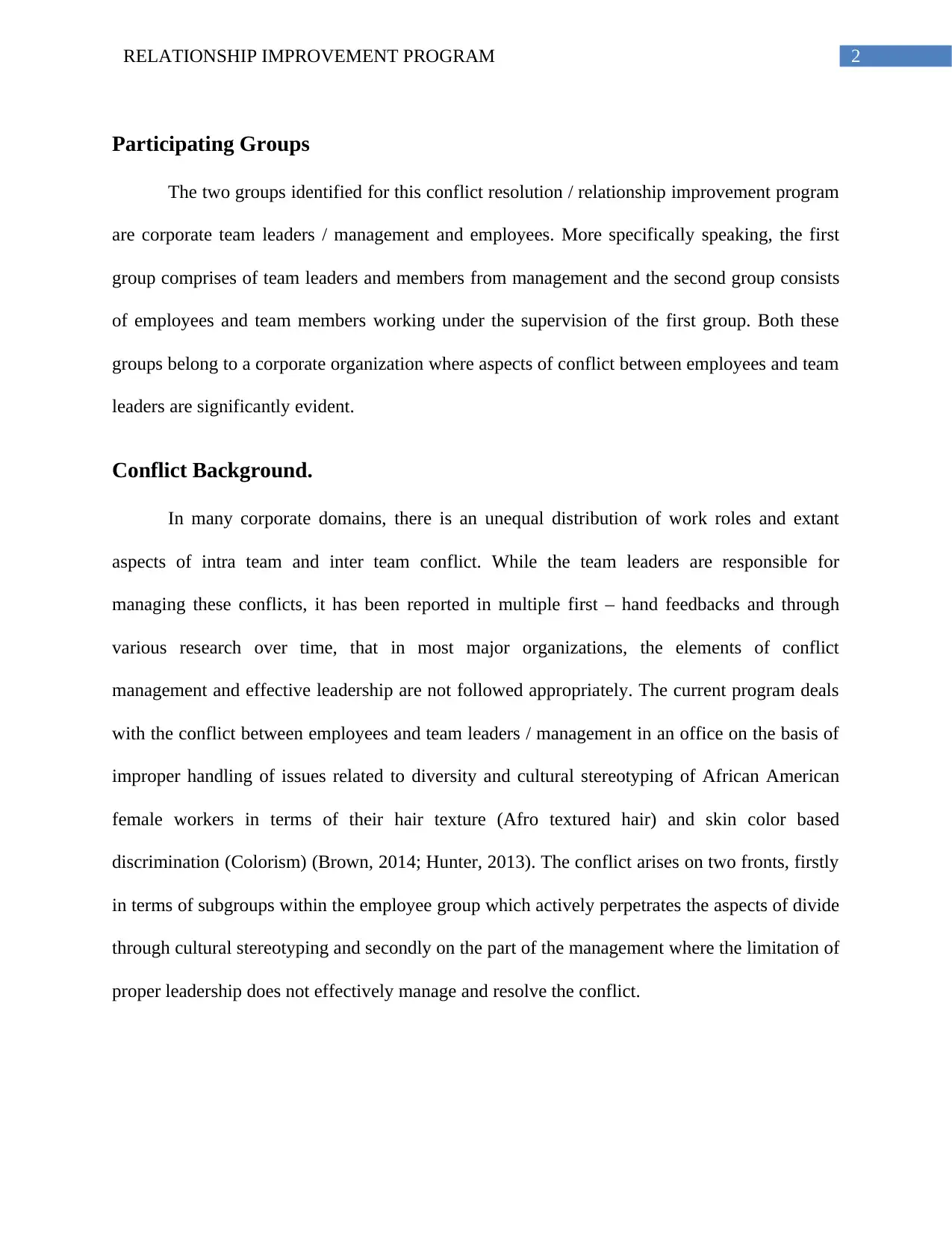
2RELATIONSHIP IMPROVEMENT PROGRAM
Participating Groups
The two groups identified for this conflict resolution / relationship improvement program
are corporate team leaders / management and employees. More specifically speaking, the first
group comprises of team leaders and members from management and the second group consists
of employees and team members working under the supervision of the first group. Both these
groups belong to a corporate organization where aspects of conflict between employees and team
leaders are significantly evident.
Conflict Background.
In many corporate domains, there is an unequal distribution of work roles and extant
aspects of intra team and inter team conflict. While the team leaders are responsible for
managing these conflicts, it has been reported in multiple first – hand feedbacks and through
various research over time, that in most major organizations, the elements of conflict
management and effective leadership are not followed appropriately. The current program deals
with the conflict between employees and team leaders / management in an office on the basis of
improper handling of issues related to diversity and cultural stereotyping of African American
female workers in terms of their hair texture (Afro textured hair) and skin color based
discrimination (Colorism) (Brown, 2014; Hunter, 2013). The conflict arises on two fronts, firstly
in terms of subgroups within the employee group which actively perpetrates the aspects of divide
through cultural stereotyping and secondly on the part of the management where the limitation of
proper leadership does not effectively manage and resolve the conflict.
Participating Groups
The two groups identified for this conflict resolution / relationship improvement program
are corporate team leaders / management and employees. More specifically speaking, the first
group comprises of team leaders and members from management and the second group consists
of employees and team members working under the supervision of the first group. Both these
groups belong to a corporate organization where aspects of conflict between employees and team
leaders are significantly evident.
Conflict Background.
In many corporate domains, there is an unequal distribution of work roles and extant
aspects of intra team and inter team conflict. While the team leaders are responsible for
managing these conflicts, it has been reported in multiple first – hand feedbacks and through
various research over time, that in most major organizations, the elements of conflict
management and effective leadership are not followed appropriately. The current program deals
with the conflict between employees and team leaders / management in an office on the basis of
improper handling of issues related to diversity and cultural stereotyping of African American
female workers in terms of their hair texture (Afro textured hair) and skin color based
discrimination (Colorism) (Brown, 2014; Hunter, 2013). The conflict arises on two fronts, firstly
in terms of subgroups within the employee group which actively perpetrates the aspects of divide
through cultural stereotyping and secondly on the part of the management where the limitation of
proper leadership does not effectively manage and resolve the conflict.
⊘ This is a preview!⊘
Do you want full access?
Subscribe today to unlock all pages.

Trusted by 1+ million students worldwide
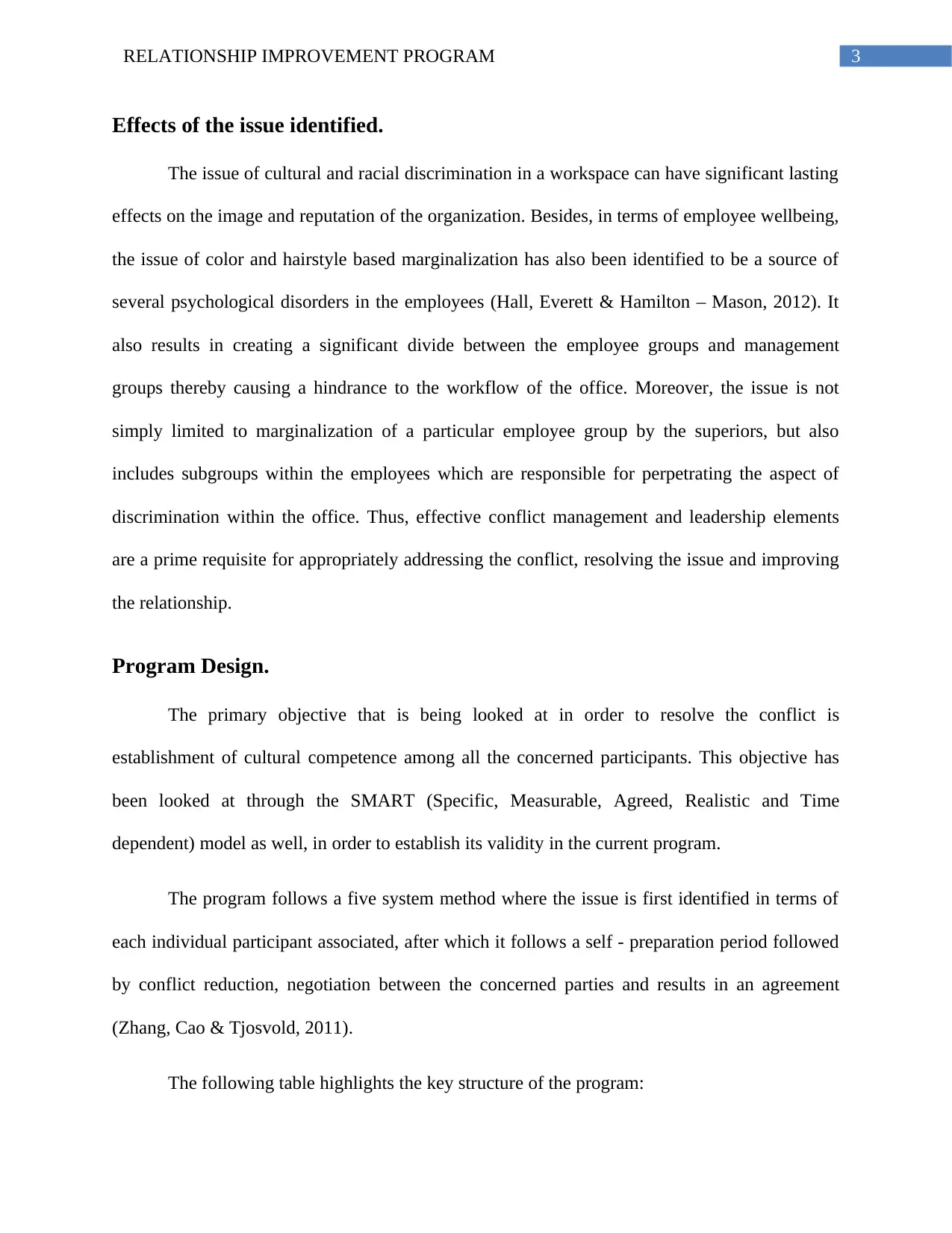
3RELATIONSHIP IMPROVEMENT PROGRAM
Effects of the issue identified.
The issue of cultural and racial discrimination in a workspace can have significant lasting
effects on the image and reputation of the organization. Besides, in terms of employee wellbeing,
the issue of color and hairstyle based marginalization has also been identified to be a source of
several psychological disorders in the employees (Hall, Everett & Hamilton – Mason, 2012). It
also results in creating a significant divide between the employee groups and management
groups thereby causing a hindrance to the workflow of the office. Moreover, the issue is not
simply limited to marginalization of a particular employee group by the superiors, but also
includes subgroups within the employees which are responsible for perpetrating the aspect of
discrimination within the office. Thus, effective conflict management and leadership elements
are a prime requisite for appropriately addressing the conflict, resolving the issue and improving
the relationship.
Program Design.
The primary objective that is being looked at in order to resolve the conflict is
establishment of cultural competence among all the concerned participants. This objective has
been looked at through the SMART (Specific, Measurable, Agreed, Realistic and Time
dependent) model as well, in order to establish its validity in the current program.
The program follows a five system method where the issue is first identified in terms of
each individual participant associated, after which it follows a self - preparation period followed
by conflict reduction, negotiation between the concerned parties and results in an agreement
(Zhang, Cao & Tjosvold, 2011).
The following table highlights the key structure of the program:
Effects of the issue identified.
The issue of cultural and racial discrimination in a workspace can have significant lasting
effects on the image and reputation of the organization. Besides, in terms of employee wellbeing,
the issue of color and hairstyle based marginalization has also been identified to be a source of
several psychological disorders in the employees (Hall, Everett & Hamilton – Mason, 2012). It
also results in creating a significant divide between the employee groups and management
groups thereby causing a hindrance to the workflow of the office. Moreover, the issue is not
simply limited to marginalization of a particular employee group by the superiors, but also
includes subgroups within the employees which are responsible for perpetrating the aspect of
discrimination within the office. Thus, effective conflict management and leadership elements
are a prime requisite for appropriately addressing the conflict, resolving the issue and improving
the relationship.
Program Design.
The primary objective that is being looked at in order to resolve the conflict is
establishment of cultural competence among all the concerned participants. This objective has
been looked at through the SMART (Specific, Measurable, Agreed, Realistic and Time
dependent) model as well, in order to establish its validity in the current program.
The program follows a five system method where the issue is first identified in terms of
each individual participant associated, after which it follows a self - preparation period followed
by conflict reduction, negotiation between the concerned parties and results in an agreement
(Zhang, Cao & Tjosvold, 2011).
The following table highlights the key structure of the program:
Paraphrase This Document
Need a fresh take? Get an instant paraphrase of this document with our AI Paraphraser
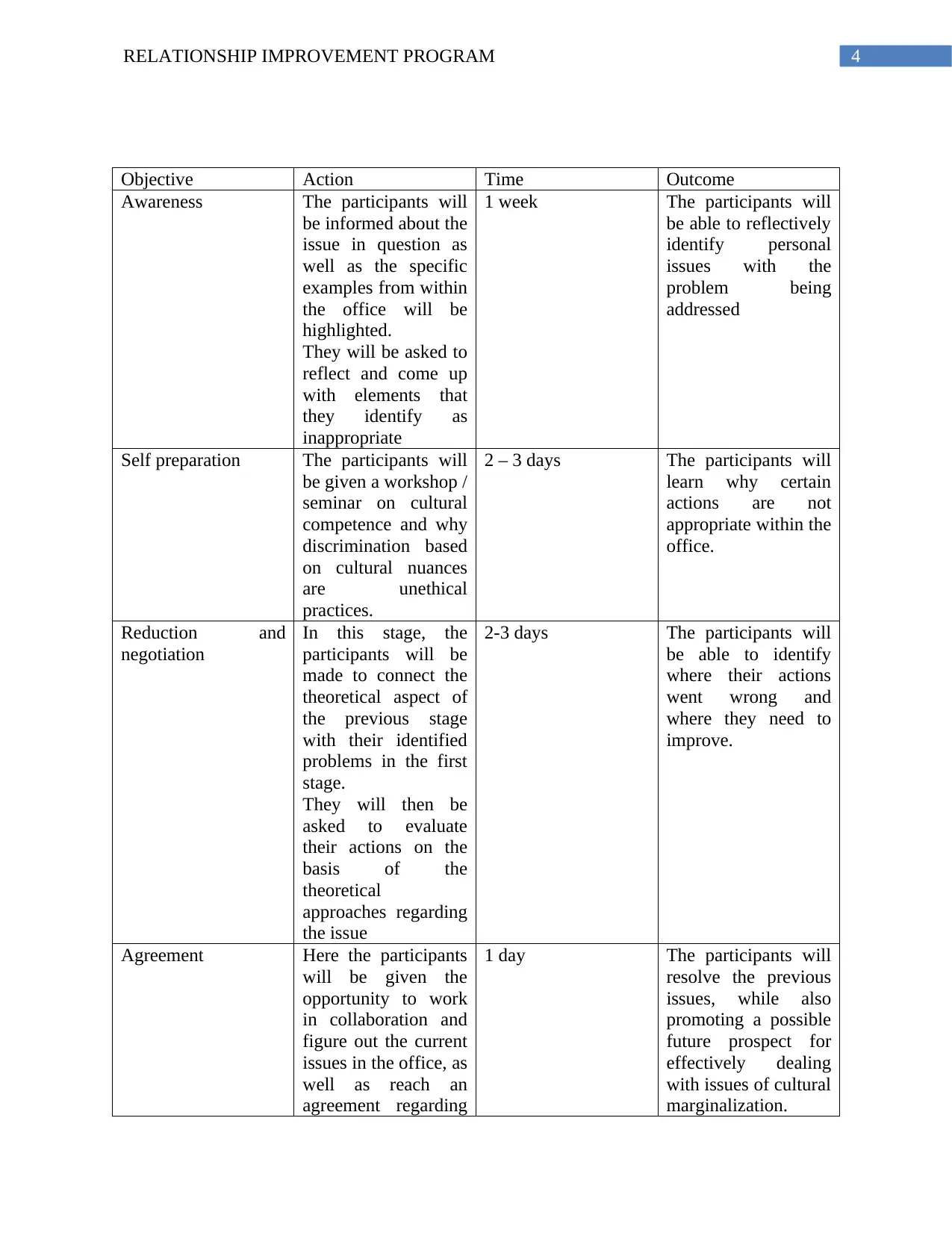
4RELATIONSHIP IMPROVEMENT PROGRAM
Objective Action Time Outcome
Awareness The participants will
be informed about the
issue in question as
well as the specific
examples from within
the office will be
highlighted.
They will be asked to
reflect and come up
with elements that
they identify as
inappropriate
1 week The participants will
be able to reflectively
identify personal
issues with the
problem being
addressed
Self preparation The participants will
be given a workshop /
seminar on cultural
competence and why
discrimination based
on cultural nuances
are unethical
practices.
2 – 3 days The participants will
learn why certain
actions are not
appropriate within the
office.
Reduction and
negotiation
In this stage, the
participants will be
made to connect the
theoretical aspect of
the previous stage
with their identified
problems in the first
stage.
They will then be
asked to evaluate
their actions on the
basis of the
theoretical
approaches regarding
the issue
2-3 days The participants will
be able to identify
where their actions
went wrong and
where they need to
improve.
Agreement Here the participants
will be given the
opportunity to work
in collaboration and
figure out the current
issues in the office, as
well as reach an
agreement regarding
1 day The participants will
resolve the previous
issues, while also
promoting a possible
future prospect for
effectively dealing
with issues of cultural
marginalization.
Objective Action Time Outcome
Awareness The participants will
be informed about the
issue in question as
well as the specific
examples from within
the office will be
highlighted.
They will be asked to
reflect and come up
with elements that
they identify as
inappropriate
1 week The participants will
be able to reflectively
identify personal
issues with the
problem being
addressed
Self preparation The participants will
be given a workshop /
seminar on cultural
competence and why
discrimination based
on cultural nuances
are unethical
practices.
2 – 3 days The participants will
learn why certain
actions are not
appropriate within the
office.
Reduction and
negotiation
In this stage, the
participants will be
made to connect the
theoretical aspect of
the previous stage
with their identified
problems in the first
stage.
They will then be
asked to evaluate
their actions on the
basis of the
theoretical
approaches regarding
the issue
2-3 days The participants will
be able to identify
where their actions
went wrong and
where they need to
improve.
Agreement Here the participants
will be given the
opportunity to work
in collaboration and
figure out the current
issues in the office, as
well as reach an
agreement regarding
1 day The participants will
resolve the previous
issues, while also
promoting a possible
future prospect for
effectively dealing
with issues of cultural
marginalization.
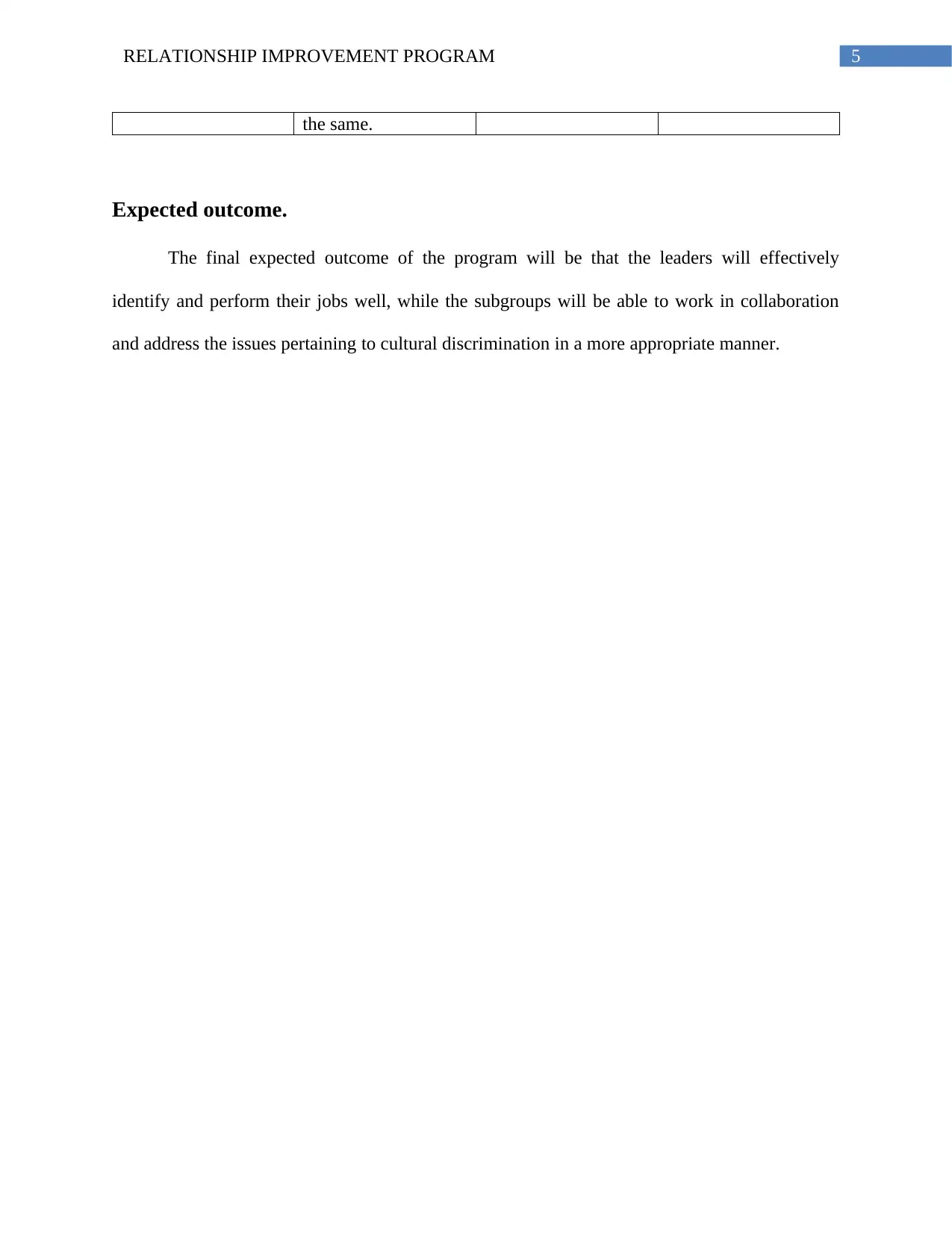
5RELATIONSHIP IMPROVEMENT PROGRAM
the same.
Expected outcome.
The final expected outcome of the program will be that the leaders will effectively
identify and perform their jobs well, while the subgroups will be able to work in collaboration
and address the issues pertaining to cultural discrimination in a more appropriate manner.
the same.
Expected outcome.
The final expected outcome of the program will be that the leaders will effectively
identify and perform their jobs well, while the subgroups will be able to work in collaboration
and address the issues pertaining to cultural discrimination in a more appropriate manner.
⊘ This is a preview!⊘
Do you want full access?
Subscribe today to unlock all pages.

Trusted by 1+ million students worldwide
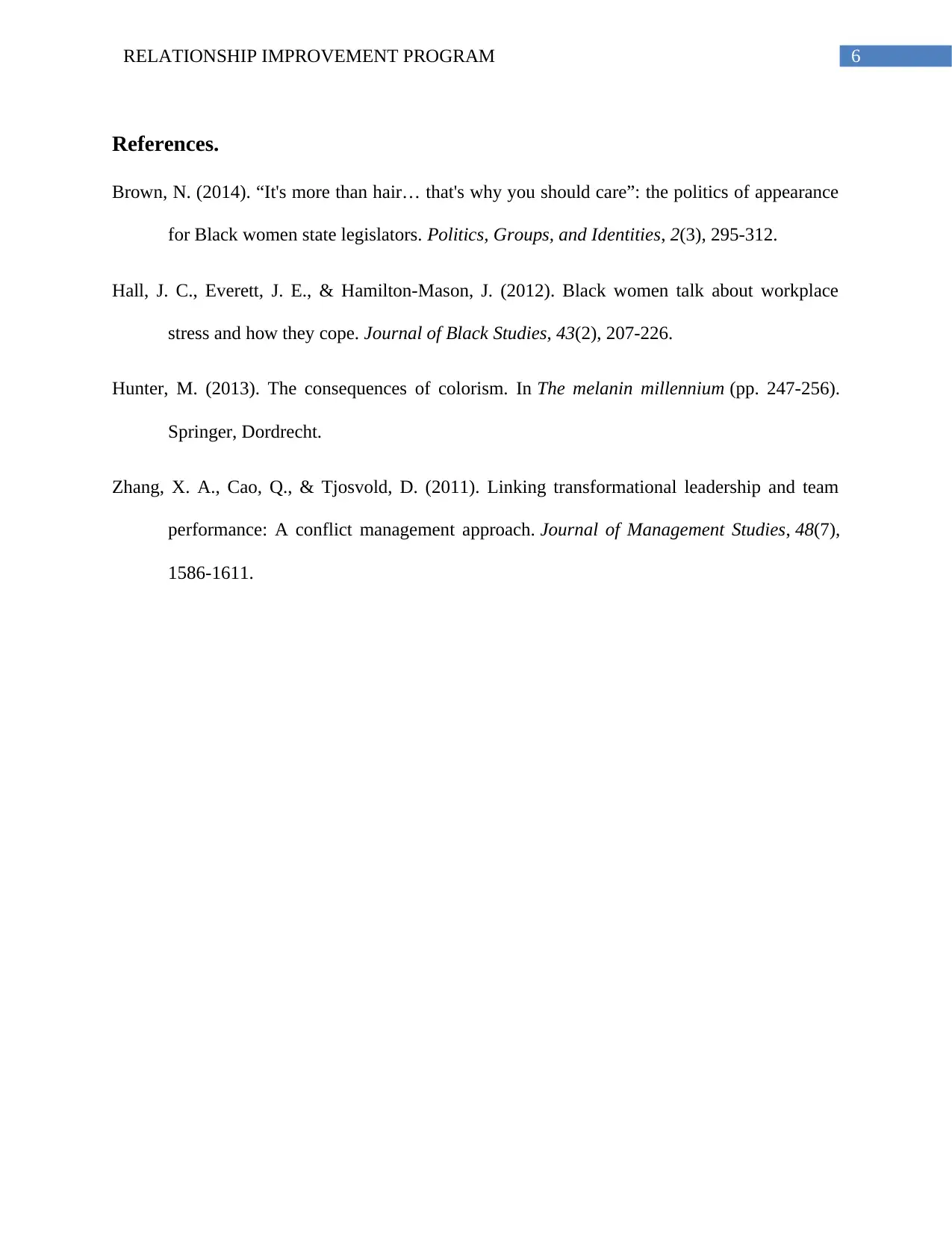
6RELATIONSHIP IMPROVEMENT PROGRAM
References.
Brown, N. (2014). “It's more than hair… that's why you should care”: the politics of appearance
for Black women state legislators. Politics, Groups, and Identities, 2(3), 295-312.
Hall, J. C., Everett, J. E., & Hamilton-Mason, J. (2012). Black women talk about workplace
stress and how they cope. Journal of Black Studies, 43(2), 207-226.
Hunter, M. (2013). The consequences of colorism. In The melanin millennium (pp. 247-256).
Springer, Dordrecht.
Zhang, X. A., Cao, Q., & Tjosvold, D. (2011). Linking transformational leadership and team
performance: A conflict management approach. Journal of Management Studies, 48(7),
1586-1611.
References.
Brown, N. (2014). “It's more than hair… that's why you should care”: the politics of appearance
for Black women state legislators. Politics, Groups, and Identities, 2(3), 295-312.
Hall, J. C., Everett, J. E., & Hamilton-Mason, J. (2012). Black women talk about workplace
stress and how they cope. Journal of Black Studies, 43(2), 207-226.
Hunter, M. (2013). The consequences of colorism. In The melanin millennium (pp. 247-256).
Springer, Dordrecht.
Zhang, X. A., Cao, Q., & Tjosvold, D. (2011). Linking transformational leadership and team
performance: A conflict management approach. Journal of Management Studies, 48(7),
1586-1611.
1 out of 7
Related Documents
Your All-in-One AI-Powered Toolkit for Academic Success.
+13062052269
info@desklib.com
Available 24*7 on WhatsApp / Email
![[object Object]](/_next/static/media/star-bottom.7253800d.svg)
Unlock your academic potential
Copyright © 2020–2025 A2Z Services. All Rights Reserved. Developed and managed by ZUCOL.





